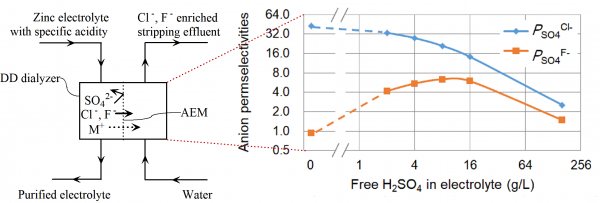侧边栏
Significantly enhanced dehalogenation selectivity in near-neutral zinc sulfate electrolytes by diffusion dialysis
J. Membr. Sci. 2018, 563, Pages 142–148 (1 Oct. 2018)
By Huan Cheng, Hui-Fang Xiao, Qing Chen, Xiu-Min Li, Wen-Meng Qin, Bao-Sheng Chen, Dong Xiao, Wei-Ming Zhang⁎
j.memsci.2018.05.053, local fulltext, mmc1.xlsx
For industries around the world, the hydrometallurgical roast–leach–electrowin process is the most common means of producing zinc metal. Dechlorination from the highly-concentrated zinc sulfate electrolyte is of vital importance to the zinc industry. In a recently published work, we innovatively employed diffusion dialysis (DD) to selectively remove Cl- and F- from a highly-acidic spent electrolyte, which extended the application of DD from acid recovery to selective ion separation. In the current paper, we greatly enhance the dechlorination selectivity by adjusting the acidity of feed electrolytes. The Cl-/SO42- permselectivity increases from 2.56 to 42.8 when the acidity is reduced from 160 to 0 g/L as free H2SO4, and meanwhile the removal ratio of Cl- impurity is basically retained (from 55.1% to 46.6%). The competitive permeation of different ions and the interplay between anions and cations are carefully investigated. It is believed that the distinct diffusivity of anions (Cl-, F-, HSO4- and SO42-) originates from their different hydrated sizes. This excellent selectivity observed here is unprecedented and has never been observed in any practical DD processes. It not only remarkably improves the cost-effectiveness of the dechlorination process in zinc production, but also puts forward a new possibility to regulate the permselectivities between ions with the same charge sign and provides new insights into the DD process in the selective ion separation.


